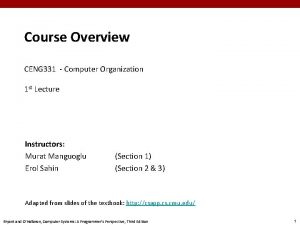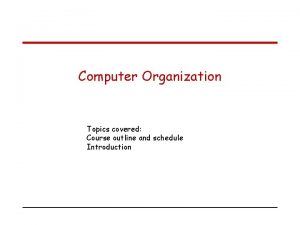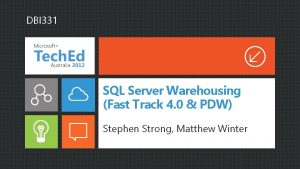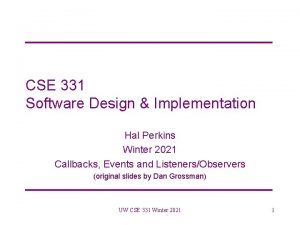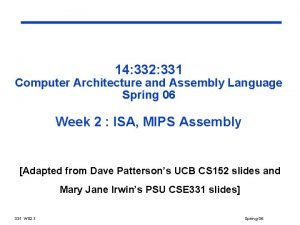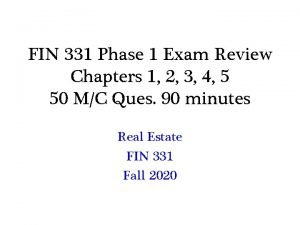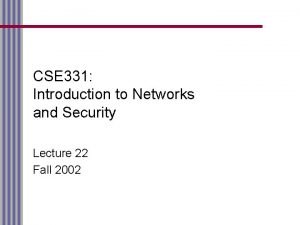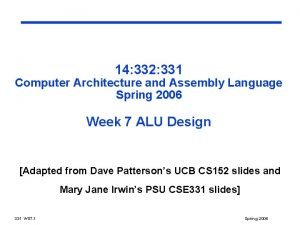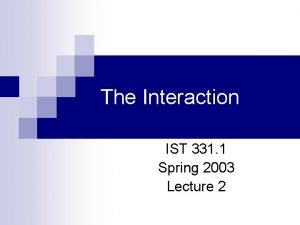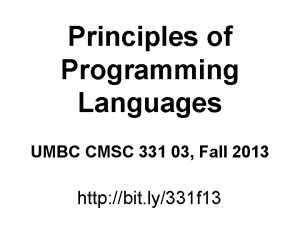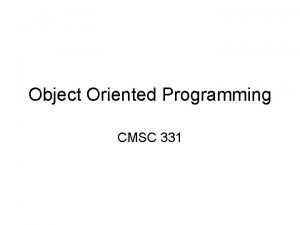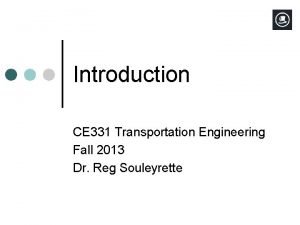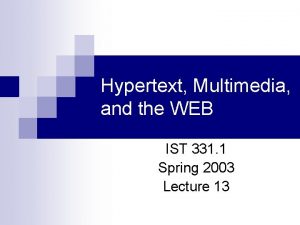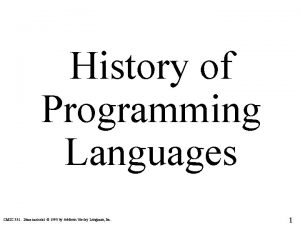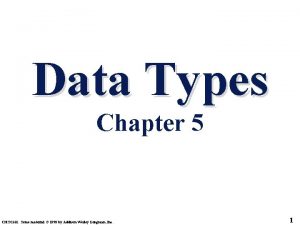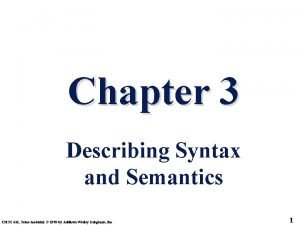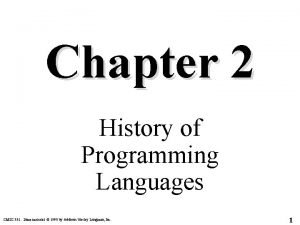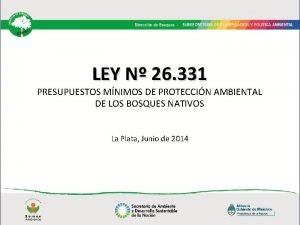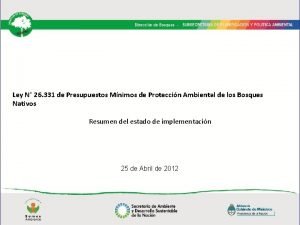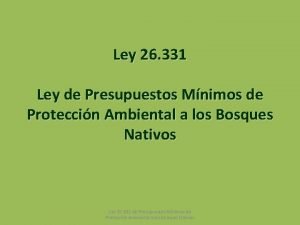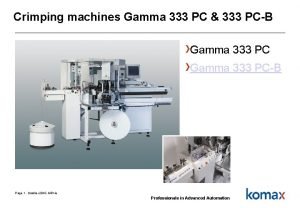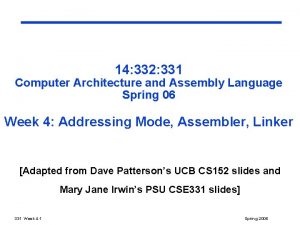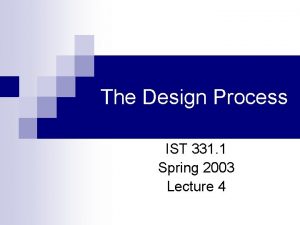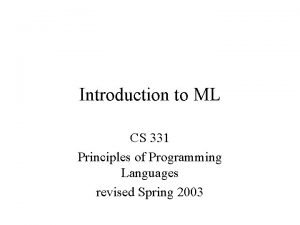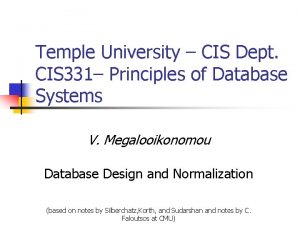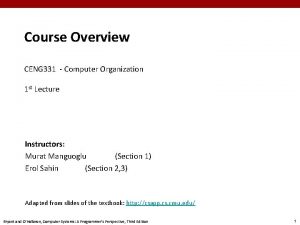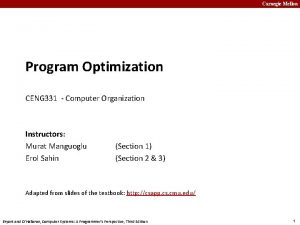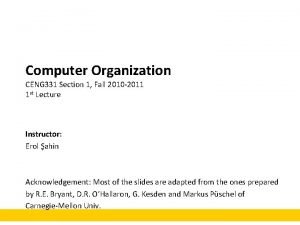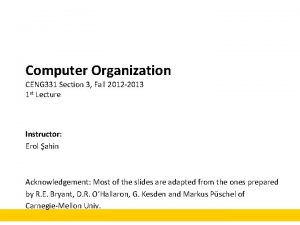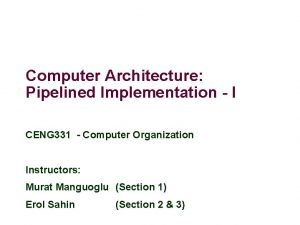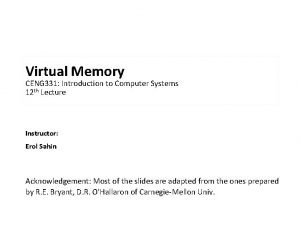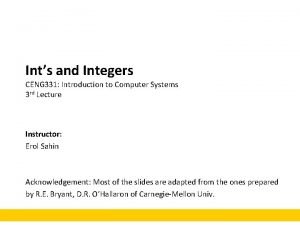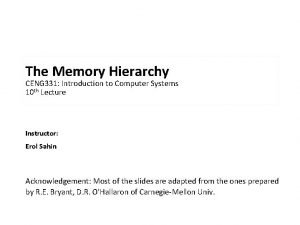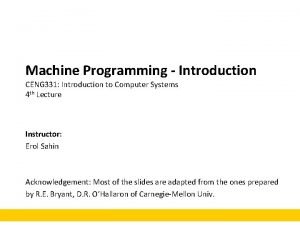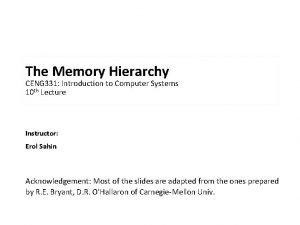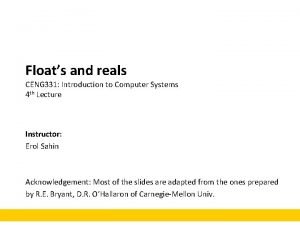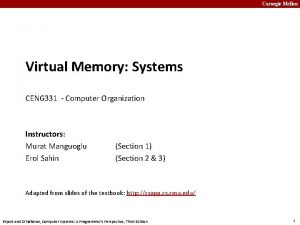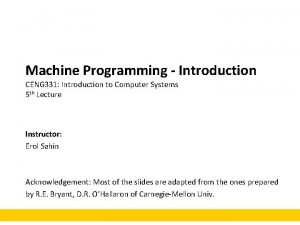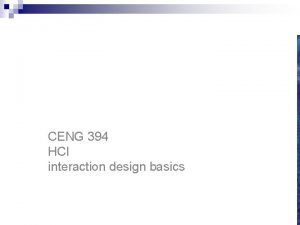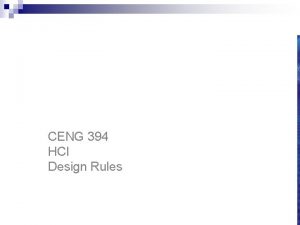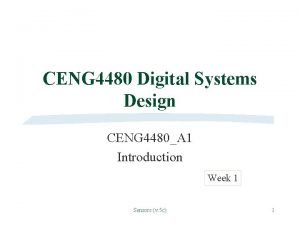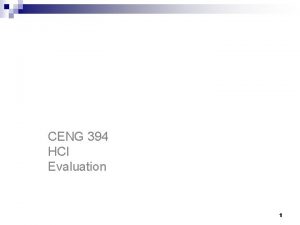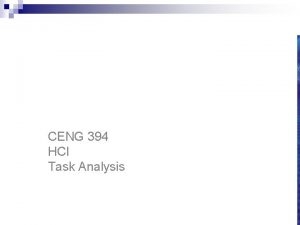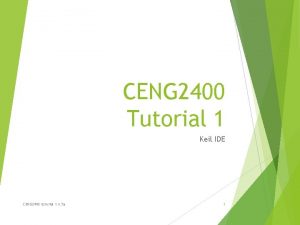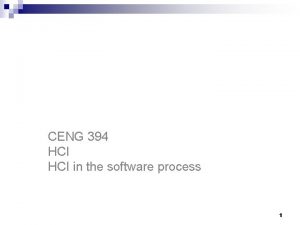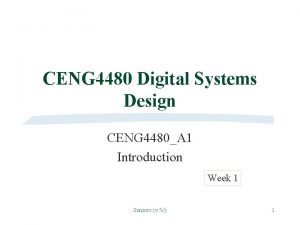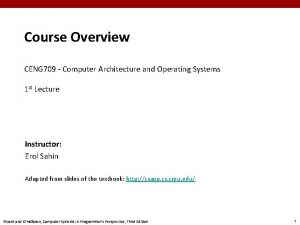Course Overview CENG 331 Computer Organization 1 st







![Memory Referencing Bug Example typedef struct { int a[2]; double d; } struct_t; double Memory Referencing Bug Example typedef struct { int a[2]; double d; } struct_t; double](https://slidetodoc.com/presentation_image_h2/414a0c76b060dc0ed3914fe158700b56/image-8.jpg)
![Memory Referencing Bug Example typedef struct { int a[2]; double d; } struct_t; fun(0) Memory Referencing Bug Example typedef struct { int a[2]; double d; } struct_t; fun(0)](https://slidetodoc.com/presentation_image_h2/414a0c76b060dc0ed3914fe158700b56/image-9.jpg)

























- Slides: 34

Course Overview CENG 331 - Computer Organization 1 st Lecture Instructors: Murat Manguoglu Erol Sahin (Section 1) (Section 2 & 3) Adapted from slides of the textbook: http: //csapp. cs. cmu. edu/ Bryant and O’Hallaron, Computer Systems: A Programmer’s Perspective, Third Edition 1

Overview Course theme ¢ Five realities ¢ How the course fits into the CENG curriculum ¢ Academic integrity ¢ Bryant and O’Hallaron, Computer Systems: A Programmer’s Perspective, Third Edition 2

Course Theme: Abstraction Is Good But Don’t Forget Reality ¢ Most CENG courses emphasize abstraction § Abstract data types § Asymptotic analysis ¢ These abstractions have limits § Especially in the presence of bugs § Need to understand details of underlying implementations ¢ Useful outcomes from taking CENG 331 § Become more effective programmers Able to find and eliminate bugs efficiently § Able to understand tune for program performance § Prepare for later “systems” classes in CS/CENG § Compilers, Operating Systems, Networks, Embedded Systems, etc. § Bryant and O’Hallaron, Computer Systems: A Programmer’s Perspective, Third Edition 3

Great Reality #1: Ints are not Integers, Floats are not Reals 2 ¢ Example 1: Is x ≥ 0? § Float’s: Yes! § Int’s: 40000 * 40000 --> 160000 § 50000 * 50000 --> ? ? § ¢ Example 2: Is (x + y) + z = x + (y + z)? § Unsigned & Signed Int’s: Yes! § Float’s: (1 e 20 + -1 e 20) + 3. 14 --> 3. 14 § 1 e 20 + (-1 e 20 + 3. 14) --> ? ? § Bryant and O’Hallaron, Computer Systems: A Programmer’s Perspective, Third Edition Source: xkcd. com/571 4

Computer Arithmetic ¢ Does not generate random values § Arithmetic operations have important mathematical properties ¢ Cannot assume all “usual” mathematical properties § Due to finiteness of representations § Integer operations satisfy “ring” properties Commutativity, associativity, distributivity § Floating point operations satisfy “ordering” properties § Monotonicity, values of signs § ¢ Observation § Need to understand which abstractions apply in which contexts § Important issues for compiler writers and serious application programmers Bryant and O’Hallaron, Computer Systems: A Programmer’s Perspective, Third Edition 5

Great Reality #2: You’ve Got to Know Assembly ¢ Chances are, you’ll never write programs in assembly § Compilers are much better & more patient than you are ¢ But: Understanding assembly is key to machine-level execution model § Behavior of programs in presence of bugs High-level language models break down § Tuning program performance § Understand optimizations done / not done by the compiler § Understanding sources of program inefficiency § Implementing system software § Compiler has machine code as target § Operating systems must manage process state § Creating / fighting malware § x 86 assembly is the language of choice! § Bryant and O’Hallaron, Computer Systems: A Programmer’s Perspective, Third Edition 6

Great Reality #3: Memory Matters Random Access Memory Is an Unphysical Abstraction ¢ Memory is not unbounded § It must be allocated and managed § Many applications are memory dominated ¢ Memory referencing bugs especially pernicious § Effects are distant in both time and space ¢ Memory performance is not uniform § Cache and virtual memory effects can greatly affect program performance § Adapting program to characteristics of memory system can lead to major speed improvements Bryant and O’Hallaron, Computer Systems: A Programmer’s Perspective, Third Edition 7
![Memory Referencing Bug Example typedef struct int a2 double d structt double Memory Referencing Bug Example typedef struct { int a[2]; double d; } struct_t; double](https://slidetodoc.com/presentation_image_h2/414a0c76b060dc0ed3914fe158700b56/image-8.jpg)
Memory Referencing Bug Example typedef struct { int a[2]; double d; } struct_t; double fun(int i) { volatile struct_t s; s. d = 3. 14; s. a[i] = 1073741824; /* Possibly out of bounds */ return s. d; } fun(0) fun(1) fun(2) fun(3) fun(4) fun(6) ➙ ➙ ➙ 3. 14 3. 1399998664856 2. 00000061035156 3. 14 Segmentation fault § Result is system specific Bryant and O’Hallaron, Computer Systems: A Programmer’s Perspective, Third Edition volatile keyword indicates that a value may change between different accesses, even if it does not appear to be modified. This keyword prevents an optimizing compiler from optimizing away subsequent reads or writes and thus incorrectly reusing a stale value or omitting writes 8
![Memory Referencing Bug Example typedef struct int a2 double d structt fun0 Memory Referencing Bug Example typedef struct { int a[2]; double d; } struct_t; fun(0)](https://slidetodoc.com/presentation_image_h2/414a0c76b060dc0ed3914fe158700b56/image-9.jpg)
Memory Referencing Bug Example typedef struct { int a[2]; double d; } struct_t; fun(0) fun(1) fun(2) fun(3) fun(4) fun(6) ➙ ➙ ➙ 3. 14 3. 1399998664856 2. 00000061035156 3. 14 Segmentation fault Explanation: struct_t Critical State 6 ? 5 ? 4 d 7. . . d 4 3 d 3. . . d 0 2 a[1] 1 a[0] 0 Bryant and O’Hallaron, Computer Systems: A Programmer’s Perspective, Third Edition Location accessed by fun(i) 9

Memory Referencing Errors ¢ C and C++ do not provide any memory protection § Out of bounds array references § Invalid pointer values § Abuses of malloc/free ¢ Can lead to nasty bugs § Whether or not bug has any effect depends on system and compiler § Action at a distance Corrupted object logically unrelated to one being accessed § Effect of bug may be first observed long after it is generated § ¢ How can I deal with this? § Program in Java, Ruby, Python, ML, … § Understand what possible interactions may occur § Use or develop tools to detect referencing errors (e. g. Valgrind) Bryant and O’Hallaron, Computer Systems: A Programmer’s Perspective, Third Edition 10

Great Reality #4: There’s more to performance than asymptotic complexity Carnegie Mellon Constant factors matter too! ¢ And even exact op count does not predict performance ¢ § Easily see 10: 1 performance range depending on how code written § Must optimize at multiple levels: algorithm, data representations, procedures, and loops ¢ Must understand system to optimize performance § How programs compiled and executed § How to measure program performance and identify bottlenecks § How to improve performance without destroying code modularity and generality Bryant and O’Hallaron, Computer Systems: A Programmer’s Perspective, Third Edition 11

Memory System Performance Example void copyij(int { int i, j; for (i = 0; i for (j = 0; dst[i][j] } src[2048], dst[2048]) < 2048; i++) j < 2048; j++) = src[i][j]; void copyji(int { int i, j; for (j = 0; j for (i = 0; dst[i][j] } src[2048], dst[2048]) < 2048; j++) i < 2048; i++) = src[i][j]; 81. 8 ms 4. 3 ms 2. 0 GHz Intel Core i 7 Haswell Hierarchical memory organization ¢ Performance depends on access patterns ¢ § Including how step through multi-dimensional array Bryant and O’Hallaron, Computer Systems: A Programmer’s Perspective, Third Edition 12

Why The Performance Differs copyij Read throughput (MB/s) 16000 14000 12000 10000 8000 copyji s 1 Stride (x 8 bytes) s 2 6000 4000 s 3 s 4 s 5 s 6 Bryant and O’Hallaron, Computer Systems: A Programmer’s Perspective, Third Edition s 7 2000 s 8 s 9 s 10 s 11 0 13

Great Reality #5: Computers do more than execute programs ¢ They need to get data in and out § I/O system critical to program reliability and performance ¢ They communicate with each other over networks § Many system-level issues arise in presence of network Concurrent operations by autonomous processes § Coping with unreliable media § Cross platform compatibility § Complex performance issues § Bryant and O’Hallaron, Computer Systems: A Programmer’s Perspective, Third Edition 14

Course Perspective ¢ Most Systems Courses are Builder-Centric § Operating Systems Implement sample portions of operating system § Compilers § Write compiler for simple language § Networking § Implement and simulate network protocols § Bryant and O’Hallaron, Computer Systems: A Programmer’s Perspective, Third Edition 15

Course Perspective (Cont. ) ¢ Our Course is Programmer-Centric § Purpose is to show that by knowing more about the underlying system, one can be more effective as a programmer § Enable you to § Write programs that are more reliable and efficient § Incorporate features that require hooks into OS – E. g. , concurrency, signal handlers § Cover material in this course that you won’t see elsewhere § Not just a course for dedicated hackers § We bring out the hidden hacker in everyone! Bryant and O’Hallaron, Computer Systems: A Programmer’s Perspective, Third Edition 16

Role within CENG Curriculum CENG 351 Databases CENG 334 Operating Systems Data Reps. Memory Model CENG 444 Language Processors CENG 371 Scientific Computing Processes Machine Mem. Mgmt Code Arithmetic CENG 336 Embedded Systems CENG 478 Parallel Computing Execution Model Memory System & Pipelining/multithreading CENG 331 CENG 232 Logic Design Bryant and O’Hallaron, Computer Systems: A Programmer’s Perspective, Third Edition 17

Textbook ¢ Randal E. Bryant and David R. O’Hallaron, § Computer Systems: A Programmer’s Perspective, Third Edition (CS: APP 3 e), Pearson, 2016 § http: //csapp. cs. cmu. edu § This book really matters for the course! § How to solve labs § Practice problems typical of exam problems Bryant and O’Hallaron, Computer Systems: A Programmer’s Perspective, Third Edition 18

Course Components ¢ Lectures § Higher level concepts ¢ Labs (5) § § § ¢ The heart of the course Preliminary + in lab sessions Preliminary work is designed to prepare you for the in-lab session They will be graded separately Provide in-depth understanding of an aspect of systems Programming and measurement Exams (midterm + final) § Test your understanding of concepts & mathematical principles Bryant and O’Hallaron, Computer Systems: A Programmer’s Perspective, Third Edition 19

Lab dates § § § Datalab Bomblab Atttacklab Processorlab Performancelab 15/10 -26/10 5/11 -16/11 20/11 -30/11 10/12 -21/12 24/12 -4/1 Bryant and O’Hallaron, Computer Systems: A Programmer’s Perspective, Third Edition 20

Getting Help ¢ COW : https: //cow. ceng. metu. edu. tr/Courses/? course=ceng 33 1&semester=20151 § Course syllabus, exams, assignments, lecture notes ¢ Newsgroup : news: //metu. ceng. course. 331 § Announcements § General questions ¢ Email communication: If you have a specific question you can send an e-mail to the instructor or to your teaching assistants. However make sure that the subject line starts with CENG 331 [capital letters, and no spaces] to get faster reply. Bryant and O’Hallaron, Computer Systems: A Programmer’s Perspective, Third Edition 21

Email communication: ¢ Specific questions: Alperen Dalkiran (dalkiran@ceng. metu. edu. tr) Ercan Selcuk Bolukbasi (ercan@ceng. metu. edu. tr) Fatih Semiz (fsemiz@ceng. metu. edu. tr) Ozan Yildiz (oyildiz@ceng. metu. edu. tr) Cemal Aker (cemal@ceng. metu. edu. tr) ¢ Our office hours: § Murat Manguoglu: Monday 14: 00 -15: 00 - A 407 manguoglu@ceng. metu. edu. tr § Erol Sahin: By appointment § erol@ceng. metu. edu. tr § Bryant and O’Hallaron, Computer Systems: A Programmer’s Perspective, Third Edition 22

Policies: Assignments And Exams ¢ Work groups § You must work alone on all assignments ¢ Exams § Written exams § Midterm 3/12/2015 § Final will be announced by METU Bryant and O’Hallaron, Computer Systems: A Programmer’s Perspective, Third Edition 23

Makeups There are no makeups unless: § Major illness, death in family, … § Submit an official report to the instructor Bryant and O’Hallaron, Computer Systems: A Programmer’s Perspective, Third Edition 24

Policies: Grading ¢ Exams (45%): midterm (20%), final (25%) ¢ Assignments (55%): 11% each Attendance: voluntary but recommended I will check attendance randomly Bryant and O’Hallaron, Computer Systems: A Programmer’s Perspective, Third Edition 25

Programs and Data ¢ Topics § Bits operations, arithmetic, assembly language programs § Representation of C control and data structures § Includes aspects of architecture and compilers ¢ Assignments § L 1 (datalab): Manipulating bits § L 2 (bomblab): Defusing a binary bomb § L 3 (attacklab): The basics of code injection attacks Bryant and O’Hallaron, Computer Systems: A Programmer’s Perspective, Third Edition 26

Processor Architecture ¢ Topics § Y 86 -64 architecture Pipelining and hazards § Control structures § ¢ Assignments § L 4(architecturelab): performance improvement in a pipelined processor architecture Bryant and O’Hallaron, Computer Systems: A Programmer’s Perspective, Third Edition 27

Code optimization and Memory Hierarchy ¢ Topics § Code optimization § Memory technology, memory hierarchy, caches, disks, locality § Includes aspects of architecture and OS ¢ Assignments § L 5 (performancelab): Improve the performance of a kernel which is a bottleneck in an application Bryant and O’Hallaron, Computer Systems: A Programmer’s Perspective, Third Edition 28

Virtual Memory ¢ Topics § Virtual memory, address translation § Includes aspects of architecture and OS Bryant and O’Hallaron, Computer Systems: A Programmer’s Perspective, Third Edition 29

Linking and Exceptional Control Flow ¢ Topics § Linking § Hardware exceptions Bryant and O’Hallaron, Computer Systems: A Programmer’s Perspective, Third Edition 30

Lab Rationale Each lab has a well-defined goal such as solving a puzzle or winning a contest ¢ Two parts: preliminary + in-lab session ¢ Doing the lab should result in new skills and concepts ¢ ¢ We try to use competition in a fun and healthy way § Set a reasonable threshold for full credit § Post intermediate results (anonymized) Bryant and O’Hallaron, Computer Systems: A Programmer’s Perspective, Third Edition 31

Cheating: Description ¢ What is cheating? § § § ¢ Sharing code: by copying, retyping, looking at, or supplying a file Describing: verbal description of code from one person to another. Coaching: helping your friend to write a lab, line by line Searching the Web for solutions Copying code from a previous course or online solution § You are only allowed to use code we supply, or from the CS: APP website What is NOT cheating? § Explaining how to use systems or tools § Helping others with high-level design issues ¢ See the course syllabus for details. § Ignorance is not an excuse Bryant and O’Hallaron, Computer Systems: A Programmer’s Perspective, Third Edition 32

Cheating: Consequences ¢ Penalty for cheating: § Disciplinary action ¢ Detection of cheating: § We have sophisticated tools for detecting code plagiarism § And other forms of cheating ¢ Don’t do it! § Start early § Ask the staff for help when you get stuck Bryant and O’Hallaron, Computer Systems: A Programmer’s Perspective, Third Edition 33

Welcome and Enjoy! Bryant and O’Hallaron, Computer Systems: A Programmer’s Perspective, Third Edition 34
 Cow ceng metu
Cow ceng metu Computer organization topics
Computer organization topics Process organization in computer organization
Process organization in computer organization Basic structure of a computer
Basic structure of a computer Difference between computer organisation and architecture
Difference between computer organisation and architecture Design of basic computer
Design of basic computer Flow chart for interrupt cycle
Flow chart for interrupt cycle Transportation planing
Transportation planing Ssis 331
Ssis 331 Uw cse 331
Uw cse 331 14:332:331
14:332:331 14:332:331
14:332:331 Fin 331 exam 1
Fin 331 exam 1 Cse 331
Cse 331 14:332:331
14:332:331 Ist 331
Ist 331 Umbc languages
Umbc languages Cmsc 331
Cmsc 331 Ce 331
Ce 331 Ist 331
Ist 331 Cmsc 331
Cmsc 331 Cmsc 331
Cmsc 331 Cmsc 331
Cmsc 331 Cmsc 331
Cmsc 331 In 331 bce, alexander the great successfully invaded egypt.
In 331 bce, alexander the great successfully invaded egypt. Ley 26 331
Ley 26 331 Ley 26 331
Ley 26 331 Ley 26 331
Ley 26 331 Komax 333
Komax 333 Pred-331
Pred-331 14:332:331
14:332:331 Ist spring design
Ist spring design 2011 plc (cs) 331
2011 plc (cs) 331 Anth 331
Anth 331 Cis 331
Cis 331
